In the Edwardian era, a matronly figure was fashionable: The typical Gibson girl S-shaped, curvy figure with low mono-bosom bust and ample hips.
The right lingerie ‘improves the fit and set of skirt and gown in wonderful degree’ (W. B. Erect Form Corsets, 1902).
The Edwardian era lasted from 1901 to 1910 and was an era of luxury with expensive fabrics and lavish lace trimmings. Even if lingerie was almost never seen, it was nevertheless trimmed with rows and rows of lace for the first time in history. Whereas lace trimmed underwear was frowned upon in the Victorian era, Edwardian lingerie was made of sheer white cotton fabric and pastel colored clingy silk fabrics – both abundantly trimmed with lace.
Related: Dressing The Victorian Woman
Even if underwear might seem less important than the dress, the right underwear provides the right silhouette for the dress.
‘It is upon the unseen foundation that the fit and grace of one’s gowns largely depend’ (New York Times, 1907).
Edwardian women wore at least three pieces of underwear: combination suit, corset and (princess) petticoat. However, they usually wore more than just three lingerie pieces! Edwardian women knew several pieces of underwear, such as the chemise (shift), drawers, combination suit, corset, brassiere, bust improver, corset cover (camisole), dress shield holder, hip pad, petticoat, short (or under) petticoat and princess slip.
Edwardian Lingerie Video
In the Edwardian era already existed videos of Edwardian women undressing. Such videos are a great source for the study of Edwardian lingerie. A while ago, I shared the following Edwardian video of a woman undressing on my instagram account. The Edwardian lingerie video is probably from the early Edwardian era, between 1901 and 1904.
This Edwardian woman wears the following underwear:
- chemise
- stockings
- corset
- corset cover
- drawers
- short petticoat
- long petticoat
Dressing The 1900s Woman – Edwardian Lingerie
The Chemise Or Combination
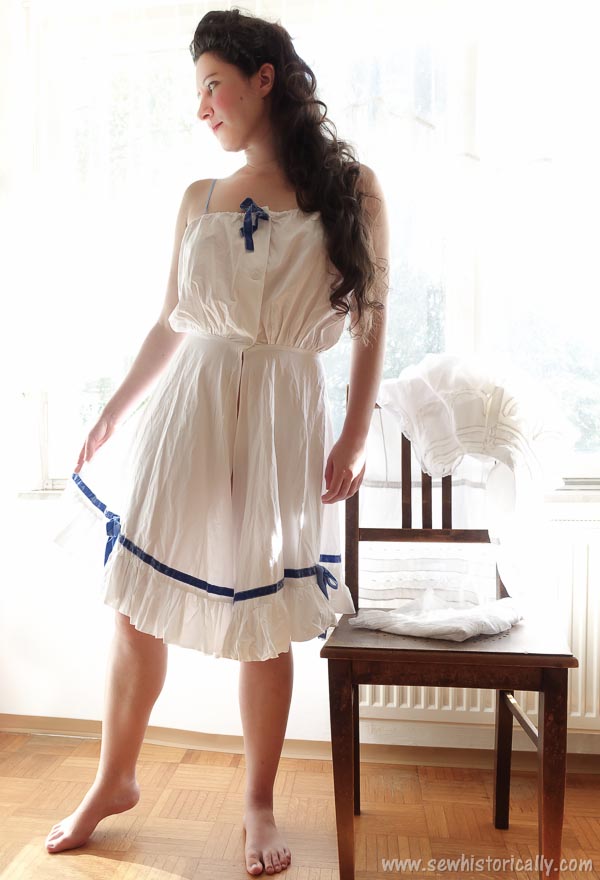
Next to her skin, Edwardian women wore a chemise – also called shift – or a combination suit. Edwardian chemises and combinations were knee-length garments usually made of white cotton fabric and lace. The Edwardian combination – or combination suit – combined chemise and drawers in one garment to reduce the bulk at the waist.
Related: Edwardian Combination
‘The chemises show their newness in their excessively short shirts, for merely to the knees is the accepted length’ (Sacramento Union, 1907) ‘This little Paris chemise […] falls to the knee […] At the top it comes only to the bust and there are dainty ribbons to tie over the shoulders. These, when the corset is adjusted over the chemise, are untied and tucked down, out of sight, so that there is only one layer of thin fabric, in the corset cover, over the shoulders.’ (Sacramento Union, 1911)
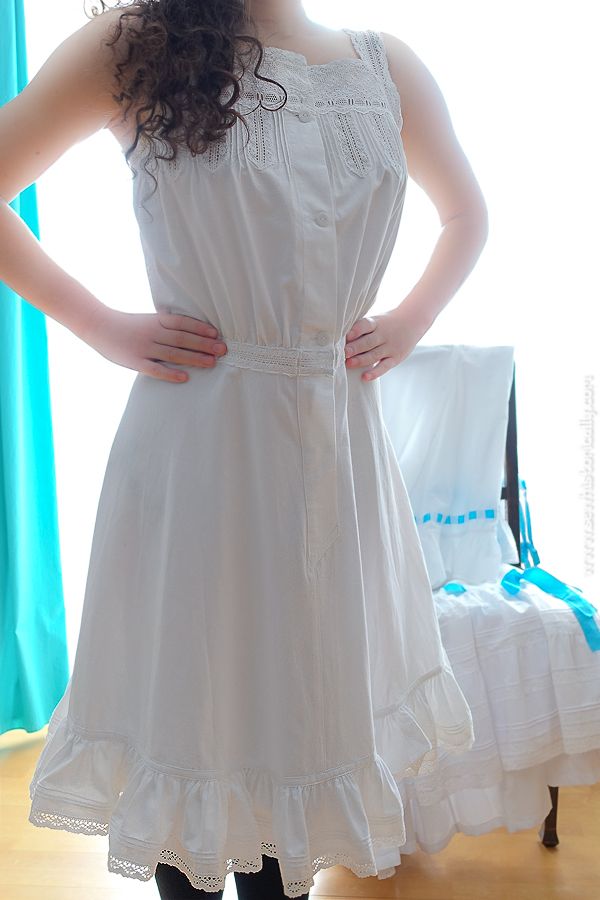
Chemises and combinations were worn to protect the corset from body oils, as well as to protect the body from the corset bones. Because it’s really uncomfortable to wear a corset without a chemise or combination under it!
Related: Refashioned Edwardian Lace Slip
The ‘ribbon corset […] may be worn over the princesse petticoat, which is a petticoat and under-waist all in one’ (Harpers Bazaar, 1901) The ‘Frenchwoman wears her chemise next her skin and always beneath her corset.’ (Sacramento Union, 1911) However, some Edwardian women wore a knitted silk vest instead of the chemise under the corset, and wore the chemise instead of a princess slip over the corset.
Related: Antique Edwardian Lace Slip
I love this antique Edwardian lace combination at the MET. And if you want to make your own Edwardian lingerie, here‘s a free combination pattern from 1919.
Drawers
If Edwardian women didn’t wear a combination, they wore drawers instead. Edwardian drawers were knee-length, usually made of white woven cotton fabric and trimmed with lace. Early in the Edwardian era, drawers had an open crotch seam because they were considered more ‘hygienic’, whereas later in the era closed drawers were preferred.
At the MFA is a beautiful pair of antique 1900s French lace drawers with open crotch seam and here‘s a free pattern from 1916 for French drawers. French drawers always had wide, flaring legs, whereas everyday drawers had knickerbocker-style legs. This Edwardian woman wears open drawers over her chemise.
Corset
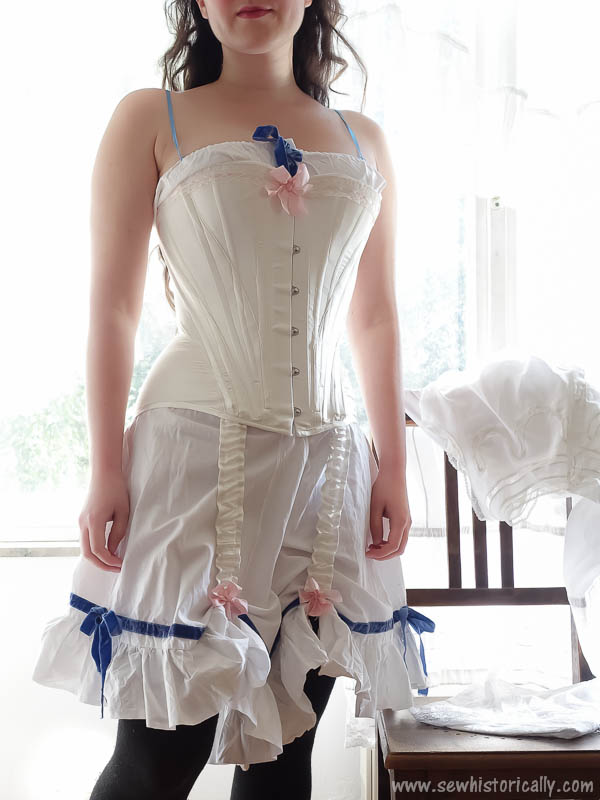
In the Edwardian era, the straight-front corset, also know as S-bend or erect form corset, was fashionable.
Related: Edwardian S-Bend Silk Corset
‘The W. B. Erect Form [corset] is built as you are built. It will develop your figure – bring out all its curves and graces – accentuate its natural beauties. Hygienic in its construction – all strain of lacing is removed from the sensitive parts of the body and thrown on the strong back muscles. The Newest Erect Form is made with extended hip and deep reach over the abdomen with the space between sharply cut away so as not to interfere with full freedom of movement.’ (W. B. Erect Form Corset Ad, 1903)
This ca. 1907 straight-front silk corset at the MET is typical of the era. And if you want to sew your own Edwardian corset, here‘s a 1908 corset pattern (scroll down, it’s the second last pattern).
Brassiere
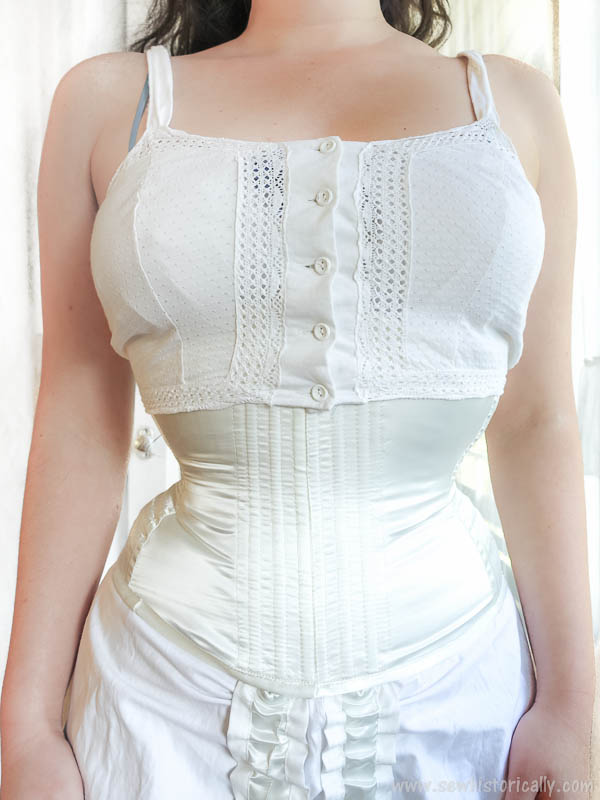
Some but not all women wore a bra, usually called brassiere in the Edwardian era, over the corset to smooth out the lines.
‘Brassieres are worn a great deal. […] The inside of this brassiere has a corset shape which laces in front, so that the figure can be pulled in and supported, while the outside of the brassiere hangs loose.’ (San Francisco Call, 1909)
‘The Brassiere, or bust bodice, is an essential garment for those who wish to keep the form neat in appearance now when the low cut corset is so much in vogue. It has the great advantage of correcting round shoulders in those who are inclined to stoop when walking, and prevents that ugly ridge so often seen in the back of the coat or blouse caused by the top of the corset.’ (Needlework Economies, 1919)
Related: Edwardian Sports Corset
Even if the vintage bra I’m wearing in the photo isn’t original Edwardian, it’s very similar to Edwardian brassieres. At the V&A is a beautiful ca. 1905 brassiere: the brassiere is trimmed with Valenciennes lace and silk ribbons.
Related: Vintage Bra Pattern
Dress Shield Holder
Edwardian corset covers sometimes had sleeves to put in dress shields. If not, some women wore separate dress shield holders. Here‘s an Edwardian dress shield holder and here‘s a tutorial on how to make your own historical dress shields.
‘This cap sleeve also gives a good chance to hide the shield.’ (New York Times, 1909)
Bust Improver & Hip Pad
Slim Edwardian women who lacked the fashionable curvy and matronly figure often wore bust improvers and hip pads. Edwardian bust improvers and hip pads were like little pillows filled with lightweight down. Here at the FIDM Museum is a 1900 hip pad shown over the petticoat. However, hip pads were worn under the petticoat or even under the corset.
Garters & Stockings
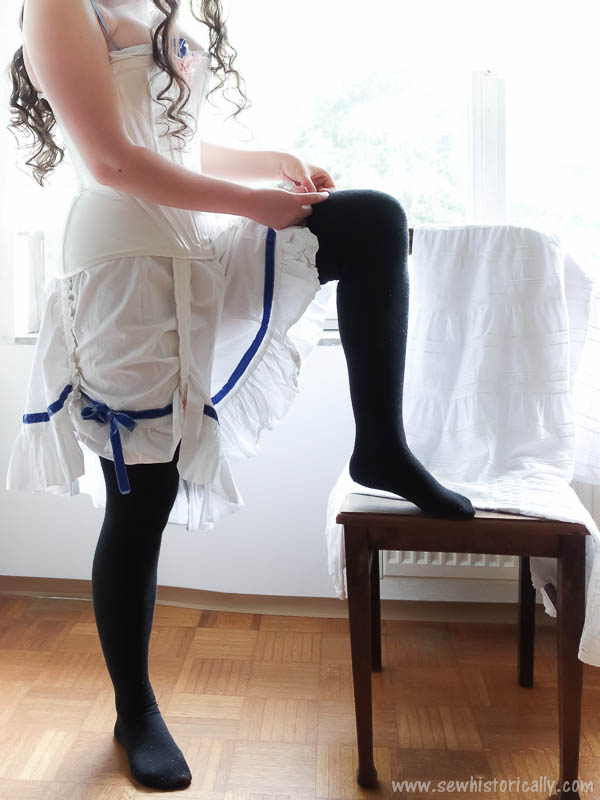
In the Edwardian era, women always wore stockings: silk, artificial silk and cotton in summer, and wool in winter. While Edwardian women obviously preferred black stockings, stocking were available in a variety of colors.
Because there were no hold-ups available in the 1900s, stockings were attached to the corset with garters to hold them up. Elastic garters ‘are hitched to the front of the corset and are worn very short, to pull down the abdomen.’ (San Francisco Call, 1902)
This Edwardian woman wears a corset with garters over her chemise.
Petticoats

Edwardian women wore at least one petticoat. One plain cotton or silk petticoat was usually worn for everyday wear, whereas special occasion garments – afternoon gowns, lingerie lace dresses and silk gowns – required more than one petticoat. If more than one petticoat was worn, the under petticoat was usually shorter, only about knee-length. Petticoats for special occasions were often elaborately trimmed with rows and rows of Valenciennes lace insertion.
Related: 2 Plain Edwardian Petticoats
‘It seems a little odd, almost indelicate to speak so openly of the petticoat as a visible part of one’s wardrobe, for always it has been a sub rosa, adjunct, or partially so. But the long skirt has banished concealment from the petticoat and the fact that it is to trail, while the dress skirt is held up, brings it prominently before the public eye.’ (San Francisco Call, 1902)
‘Berkeley cambric and longcloth are suitable for petticoats to wear with cotton and linen dresses. […] Silk is very generally used for petticoats to be worn with tailored suits and dresses of wool, silk and linen.’ (Clothing For Women: Selection, Design, Construction, 1916)
Related: Edwardian Tailored Wool Skirt
At the MET is a 1903 wedding lingerie set consisting of chemise, drawers, corset, corset cover and petticoat, and here‘s a basic petticoat pattern from 1908 (scroll down, it’s the last pattern).
Corset Cover
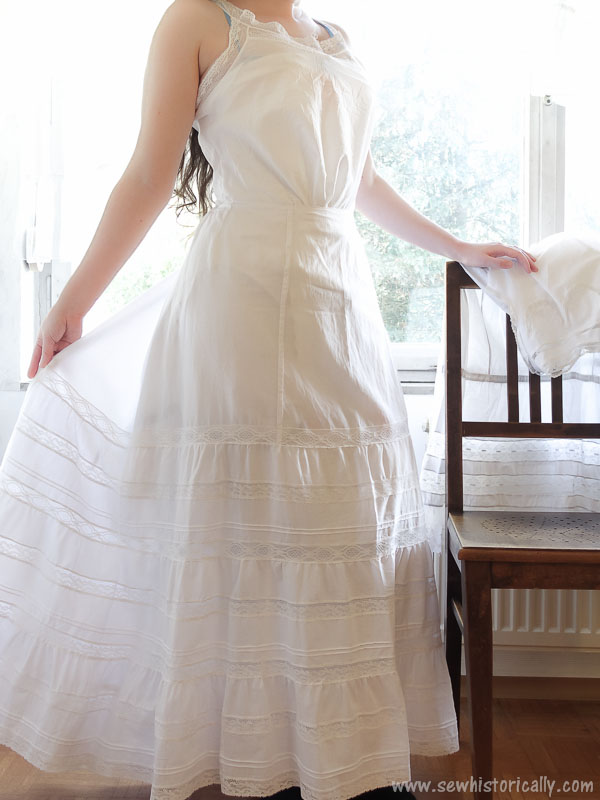
The corset cover, also called camisole, was worn over the corset. ‘The corset cover is a garment worn by every girl.’ (Garments For Girls, 1919) In the Edwardian era, corset covers were worn to protect the corset as well as to smooth out the lines of the corset bones.
Here‘s a free pattern for a corset cover from 1911.
Princess Slip
Some Edwardian women preferred to wear a princess slip or princess petticoat instead of a separate corset cover and petticoat. The princess slip simply combined a bloused or fitted corset cover and petticoat in one garment.
‘Dressed in this fashion, a woman is more comfortable than she has ever been. Her underclothes are reduced to minimum weight, her waistline is natural and not made larger by strings, buttons, and belts, and the lack of petticoats gives her greater freedom in walking.’ (New York Times, 1909)
At the Met are two antique lace slips: a fitted princess slip and a combination corset cover and petticoat with bloused effect for the fashionable Edwardian pouter pigeon shape.
More Antique Edwardian Lingerie On My Pinterest Board ‘1900s Lingerie’:
Please Pin It!


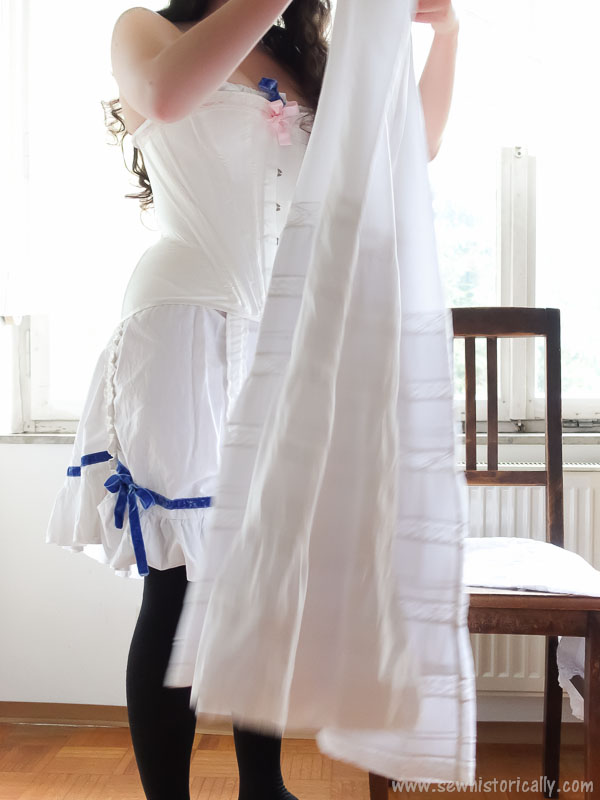
Thank you, very intresting! I have a question, how did girls hold their stockings as they were not yet wearing corsets ? I refer to white stockings we see in photographs from that era. Thank you 🙂
Girls often wore Ferris waists – soft (corded) bodices – with garters. For younger girls, these waists looked like unshaped tank tops and were already being advertised for babies!
This was lovely and informative. I am researching a book I am (hopefully, she says) going to write. I’d like my details to be at least mostly correct, even if it is fiction. Thanks!
Thank you! Glad you found it helpful! 😀